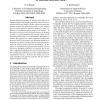Free Online Productivity Tools
i2Speak
i2Symbol
i2OCR
iTex2Img
iWeb2Print
iWeb2Shot
i2Type
iPdf2Split
iPdf2Merge
i2Bopomofo
i2Arabic
i2Style
i2Image
i2PDF
iLatex2Rtf
Sci2ools
CVPR
2004
IEEE
2004
IEEE
Motion Without Correspondence from Tomographic Projections by Bayesian Inversion Theory
In conventional tomography, the interior of an object is reconstructed from tomographic projections such as X-ray or electron microscope images. All the current reconstruction methods assume that projection geometry of the imaging device is either known or solved in advance by using e.g. fiducial or non-fiducial feature points in the images. In this paper, we propose a novel approach where the imaging geometry is solved simultaneously with the volume reconstruction problem while no correspondence information is needed. Our approach is a direct application of Bayesian inversion theory and produces the maximum likelihood or maximum a posteriori estimates for the motion parameters under the selected noise and prior distributions. In this paper, we experiment the approach with synthetic and real data where 1D affine projections are assumed; this is also often a sufficient assumption since the reconstruction problem is frequently performed as a stack of 2D problems for computational reason...
Computer Vision | Current Reconstruction Methods | CVPR 2004 | Electron Microscope Images | Reconstruction Problem |
| Added | 20 Aug 2010 |
| Updated | 20 Aug 2010 |
| Type | Conference |
| Year | 2004 |
| Where | CVPR |
| Authors | Sami S. Brandt, Ville Kolehmainen |
Comments (0)

